Italeri 1/72 YF-22A Lightning II
|
KIT #: |
? |
|
PRICE: |
$14.99 MSRP |
|
DECALS: |
One option |
|
REVIEWER: |
Carmel J. Attard |
|
NOTES: |
Prototype |
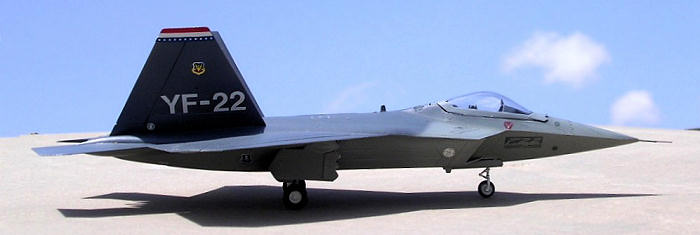
The YF-22 is destined to replace the F-15 in the
USAF inventory. It represents the top of technology having an aerodynamic
unparalleled design indication of the shape of future fighter aircraft. He YF-22
promises to be the single most effective air superiority aircraft of the modern
era which combines speed and stealth in an agile airframe that was the most
advanced weapon and systems to find and kill its target without warning. Its
sophisticated electronic gear and engines demonstrate a completely new concept
which presents a maximum of reliability and achievement.
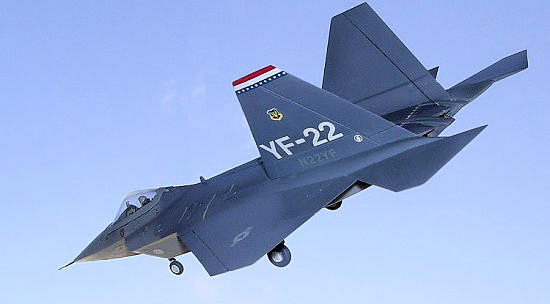 The
YF-22 design was always heavily influenced by the F-117 stealth technology and
when it was unveiled in August 1991 some observers pointed to its resemblance.
More advanced in design and testing techniques allowed the F-22 to avoid the
hard faceted edges of the stealth fighter. The YF-22 tail fins were huge as
Lockheed wished to avoid the control problems they had experienced on the F-117s
early flights caused by its too small tail surfaces.
The
YF-22 design was always heavily influenced by the F-117 stealth technology and
when it was unveiled in August 1991 some observers pointed to its resemblance.
More advanced in design and testing techniques allowed the F-22 to avoid the
hard faceted edges of the stealth fighter. The YF-22 tail fins were huge as
Lockheed wished to avoid the control problems they had experienced on the F-117s
early flights caused by its too small tail surfaces.
Two YF-22s were built, the first prototype N22YF
was powered by a General Electric YF120 variable-cycle engines while the second
N22YX used the Pratt and Whitney YF 119. The first prototype was also fitted for
a time with spin recovery parachute for use during bending and high-alpha
trials. When Lockheed won the Dem/Val Competition in 1991, N22YF did not fly
again. The secondYF-22 returned to flight duties in October 1991, this time
wearing its USAF serial 87-701. The YF-22 flew 39 times which is more than it
had during the Dev/Val stage. Its contribution was limited by the major changes
between it and the final F-22A design. The YF-22 was conducting a series of
oscillations during a low, slow pass along the Edwards runway when it crashed in
April 1992. It slid 8,000 feet and burned. In due course the airframe was
repaired. The YF-22 was then used to test antenna designs for the F-22A at the
Griffiths AFB.
The F-22 is the replacement for the F-117 and
F-15E fleet, and the Raptors as the F-22 is now christened are beginning to
equip squadrons in USAF service at Langley AB Virginia, Tyndall AB Florida and
Elmendorf
AB,
Alaska.
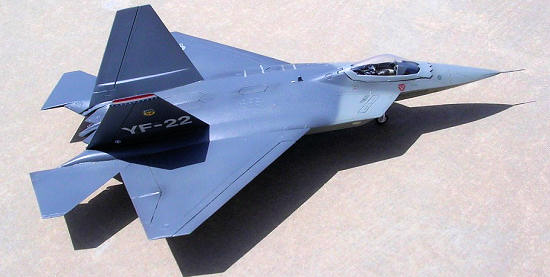 The
YF-22 Lightning II is an amazingly complete yet simple kit of a fascinating
subject which is the forerunner of the present day F22
Raptor. The parts come in light grey injection moulded plastic having good
surface detail which is also well defined. The kit comes with a folded out
instructions having easy to follow steps of construction. There is a sprue
diagram and at the back of the colour kit box has a useful 4-view drawing for
colour markings and decal emplacement. There is a fully detailed cockpit
consisting of neatly moulded parts. The fuselage is split horizontally which
also integrates the main planes. There is an appreciable amount of detail to the
undercarriage. One of the three weapon bays, the main central one, can be built
in the open or closed configuration. It can exhibit a cluster of four AMRAAM
missiles mounted on a central rack.
The
YF-22 Lightning II is an amazingly complete yet simple kit of a fascinating
subject which is the forerunner of the present day F22
Raptor. The parts come in light grey injection moulded plastic having good
surface detail which is also well defined. The kit comes with a folded out
instructions having easy to follow steps of construction. There is a sprue
diagram and at the back of the colour kit box has a useful 4-view drawing for
colour markings and decal emplacement. There is a fully detailed cockpit
consisting of neatly moulded parts. The fuselage is split horizontally which
also integrates the main planes. There is an appreciable amount of detail to the
undercarriage. One of the three weapon bays, the main central one, can be built
in the open or closed configuration. It can exhibit a cluster of four AMRAAM
missiles mounted on a central rack.
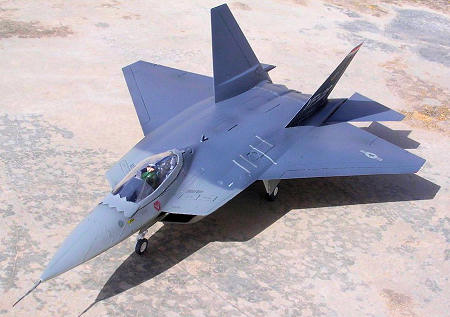 I
preferred to assemble the bay with the doors closed as the detail inside did not
appear effective and was rather scarce. The
somewhat complicated intake contours are discontinuous and require additional
work to rectify the missing interior wall with a measurably cut plastic card and
fitted in place in both intakes. These were in the form of rectangular panels
that once cut to measure are glued on the interior to form a continuous ducting.
The YF-22 carried a pitot tube at the nose front. This I replaced with one made
from a metal pin. Nose balance weight is added to the inside as forward as can
be permitted. The cockpit is painted light grey with dark grey coming. Decals
for instruments also added. The whole assembly is inserted in the upper
fuselage. The wing/ fuselage halves are then fixed together without any major
problems. The crystal clear canopy which had serrated front and hinged at the
rear is the last thing to go on the kit and can be fixed open or closed.
I
preferred to assemble the bay with the doors closed as the detail inside did not
appear effective and was rather scarce. The
somewhat complicated intake contours are discontinuous and require additional
work to rectify the missing interior wall with a measurably cut plastic card and
fitted in place in both intakes. These were in the form of rectangular panels
that once cut to measure are glued on the interior to form a continuous ducting.
The YF-22 carried a pitot tube at the nose front. This I replaced with one made
from a metal pin. Nose balance weight is added to the inside as forward as can
be permitted. The cockpit is painted light grey with dark grey coming. Decals
for instruments also added. The whole assembly is inserted in the upper
fuselage. The wing/ fuselage halves are then fixed together without any major
problems. The crystal clear canopy which had serrated front and hinged at the
rear is the last thing to go on the kit and can be fixed open or closed.
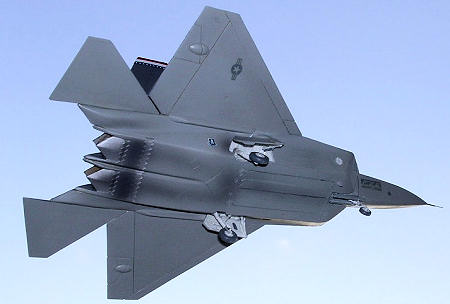 The
bay and wheel wells are semi matt white. The lower surface of the kit was then
airbrushed in light ghost grey FS36375 for which I used Humbrol 64 and the upper
surface was in two tone grey camouflage FS36320, Humbrol 126 and the darker
grey, Gunship grey FS36118. For the equivalent I used Modelmaster 1728. Decals
cater for the first prototype which is of good quality. I simply trimmed the
excessive carrier film that goes outside of the decal. The three colour stripes
only go to the outer surface of the fins upper. A decorative crest decal fits to
each side of the air intakes and the remaining decals were quite effective on
the overall appearance of the kit.
The complete kit was
finished in satin varnish by Model Master.
The
bay and wheel wells are semi matt white. The lower surface of the kit was then
airbrushed in light ghost grey FS36375 for which I used Humbrol 64 and the upper
surface was in two tone grey camouflage FS36320, Humbrol 126 and the darker
grey, Gunship grey FS36118. For the equivalent I used Modelmaster 1728. Decals
cater for the first prototype which is of good quality. I simply trimmed the
excessive carrier film that goes outside of the decal. The three colour stripes
only go to the outer surface of the fins upper. A decorative crest decal fits to
each side of the air intakes and the remaining decals were quite effective on
the overall appearance of the kit.
The complete kit was
finished in satin varnish by Model Master.
The
finished kit appeared
to capture all the lines of the YF-22 Lightning II. The aircraft itself differed
greatly from the eventual evolving F-22 Raptor production aircraft. Definitely
recommended to those modellers who follow the development of the future fighter
aircraft F-22A Raptor.
 World Air Power Journal Vol 38 Aut/Fall 1999
World Air Power Journal Vol 38 Aut/Fall 1999
Carmel J. Attard
June 2008
If you would like your product reviewed fairly and fairly quickly, please
contact
the editor or see other details in the
Note to
Contributors.
Back to the Main Page
Back to the Review Index Page



 The
YF-22 Lightning II is an amazingly complete yet simple kit of a fascinating
subject which is the forerunner of the present day F22
Raptor. The parts come in light grey injection moulded plastic having good
surface detail which is also well defined. The kit comes with a folded out
instructions having easy to follow steps of construction. There is a sprue
diagram and at the back of the colour kit box has a useful 4-view drawing for
colour markings and decal emplacement. There is a fully detailed cockpit
consisting of neatly moulded parts. The fuselage is split horizontally which
also integrates the main planes. There is an appreciable amount of detail to the
undercarriage. One of the three weapon bays, the main central one, can be built
in the open or closed configuration. It can exhibit a cluster of four AMRAAM
missiles mounted on a central rack.
The
YF-22 Lightning II is an amazingly complete yet simple kit of a fascinating
subject which is the forerunner of the present day F22
Raptor. The parts come in light grey injection moulded plastic having good
surface detail which is also well defined. The kit comes with a folded out
instructions having easy to follow steps of construction. There is a sprue
diagram and at the back of the colour kit box has a useful 4-view drawing for
colour markings and decal emplacement. There is a fully detailed cockpit
consisting of neatly moulded parts. The fuselage is split horizontally which
also integrates the main planes. There is an appreciable amount of detail to the
undercarriage. One of the three weapon bays, the main central one, can be built
in the open or closed configuration. It can exhibit a cluster of four AMRAAM
missiles mounted on a central rack. I
preferred to assemble the bay with the doors closed as the detail inside did not
appear effective and was rather scarce.
I
preferred to assemble the bay with the doors closed as the detail inside did not
appear effective and was rather scarce. The
bay and wheel wells are semi matt white. The lower surface of the kit was then
airbrushed in light ghost grey FS36375 for which I used Humbrol 64 and the upper
surface was in two tone grey camouflage FS36320, Humbrol 126 and the darker
grey, Gunship grey FS36118. For the equivalent I used Modelmaster 1728. Decals
cater for the first prototype which is of good quality. I simply trimmed the
excessive carrier film that goes outside of the decal. The three colour stripes
only go to the outer surface of the fins upper. A decorative crest decal fits to
each side of the air intakes and the remaining decals were quite effective on
the overall appearance of the kit.
The
bay and wheel wells are semi matt white. The lower surface of the kit was then
airbrushed in light ghost grey FS36375 for which I used Humbrol 64 and the upper
surface was in two tone grey camouflage FS36320, Humbrol 126 and the darker
grey, Gunship grey FS36118. For the equivalent I used Modelmaster 1728. Decals
cater for the first prototype which is of good quality. I simply trimmed the
excessive carrier film that goes outside of the decal. The three colour stripes
only go to the outer surface of the fins upper. A decorative crest decal fits to
each side of the air intakes and the remaining decals were quite effective on
the overall appearance of the kit. World Air Power Journal Vol 38 Aut/Fall 1999
World Air Power Journal Vol 38 Aut/Fall 1999